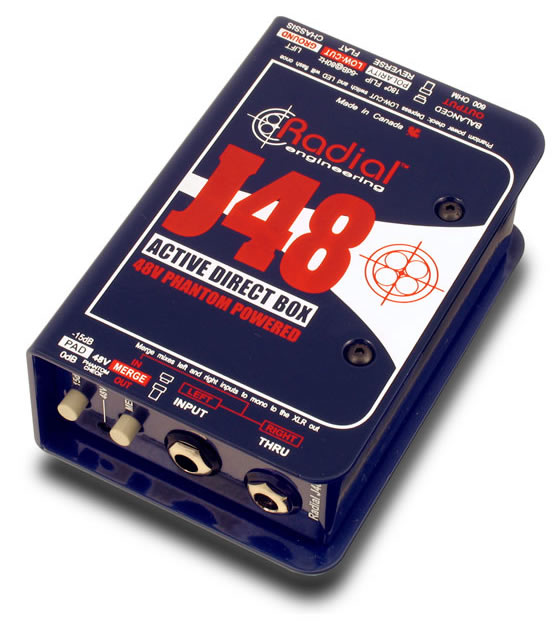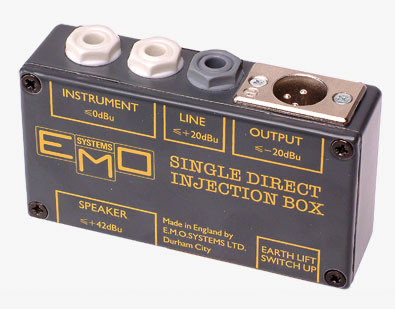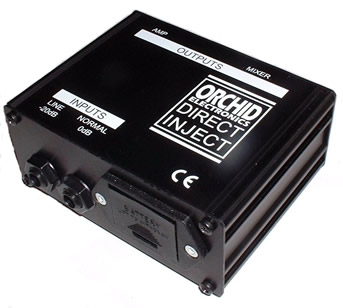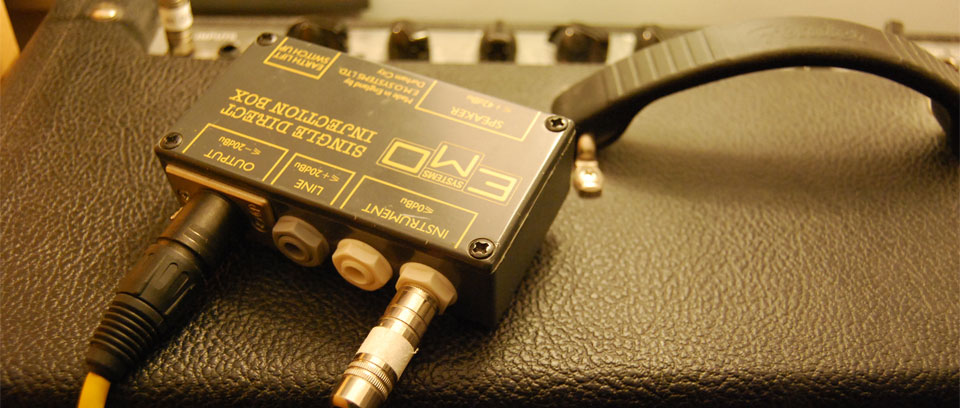Now, click to watch our video at our sister site ..
In the studio or on stage the DI box performs several functions, primarily ...
- Match the differing output impedances (Z) and levels of two devices to allow interconnection (eg guitar pickup output and mic pre-amp input).
- Convert an unbalanced mic or line level signal to a balanced one.
- Provide a way for an electric guitar or electric bass guitar to connect directly to a mixing desk/mic pre-amp.
- Provide a way for an electric guitar or electric bass guitar to simultaneously connect to a guitar amplifier and a mic pre-amp.
- Provide a way to connect the line level output (eg headphone jack) of a laptop to a mixing desk without buzzes and hum.
- Provide a way to route a signal to a variety of differing outputs (eg mic pre-amp, guitar amplifier, tuners, speakers)
- Solve earth/ground-loop hum and buzz problems.
- To improve the electrical safety of connection between components.
More on impedance
Differing devices (guitar pickups, microphones, mic pre-amps etc) have differing impedances (Z). This causes problems when connecting one to another. Mismatching can result in problems such as loss of high or low frequency and overall level.
For example, the high impedance unbalanced instrument level output of an electric bass or guitar pickup needs to be converted to low impedance mic level if the signal is to be sent to the mic pre-amp of a mixer, voice channel, soundcard or audio interface.
The lower the impedance (Z) of the signal, the lower the resistance offered by the wire it travels in.
Impedance (Z) = the resistance in an AC (Alternating Current) circuit.
Resistance = Resistance in a DC (Direct Current) circuit.
DI'ing electric guitars and bass guitars
In the studio, one of the primary applications of a DI box is to allow the direct connection of guitars to studio equipment (usually either mic pre-amps or effect processors). This allows the unaltered sound coming from the pickups to be captured. This is sometimes desirable for the following reasons ...
- to transparently capture the wide frequency response of an electric guitar or electric bass guitar pickup. Guitar amplifiers/speakers filter out hi-freq and introduce significant amounts of tonal colour into the signal which is not always required.
- to record an electric guitar that will later be re-amped (sent back out to an amplifier) or processed with software emulations
- to allow a guitar signal to be processed by a stand alone effect processor
It should be noted that acoustic guitar piezo type pickups require a higher impendence input (typically 1Mega Ohm) than electric guitar and electric bass guitar pickups. Not all DI boxes provide hi Z inputs.
Types of DI Box
The Radial J48, a popular active DI box
with output transformer

EMO's popular single channel passive DI box

Orchid Electronics active DI with
hi impedance
input but without an output transformer

Passive
The passive DI box has no powered electrical circuitry and comprises only passive components, a few resistors and an output transformer. When an electric guitar or bass is connected, the circuitry is driven solely by the signal from the pickup.
In cheaper designs, this can result in the so called "loading effect" which causes a deterioration in sound quality, often noticeable by a loss of the natural tonal balance and high frequency. In addition, the response of the pickup is altered leading to a change in the playability of an instrument. This effect can be large or minimal depending on the design/quality of the DI box and the design/type of pickup, which itself may be active or passive.
Active
An active DI box contains a buffering amplifier which isolates a guitars pickup from the loading effect, potentially helping a guitar pickup to operate as it should. Active designs allow for more features such as hi-impedance and line inputs.
A disadvantage is that they are more expensive and require power, usually in the form of 48v phantom power sent from a mic pre-amp. Many models have battery compartments which can be fitted with a 9v battery for situations such as live performance, where phantom power is unavailable. However, using the lower voltages results in a loss in signal to noise and high frequency performance. This may not be either a problem or noticeable with electric guitars and electric bass guitars.
Typical DI Box features
Instrument input
This will accept the unbalanced low level signal (typically up to 1volt) from an electric guitar or electric bass guitar pickup.
Line input
This will accept an unbalanced line level signal (typically up to 30volts), from a source such as a keyboard or synth, and convert it to a balanced signal. Often used to transmit signals long distances, such as from a stage to a mixer located at the back of a venue, free from signal loss or interference.
Speaker input
This will accept a high level signal (typically up to 100volts) from an amplifiers speaker output, or a guitar cabinets speaker thru/output, which may then be sent to mixer.
Balanced output
This normally carries a mic level signal to a mixer channel/mic pre-amp.
Output transformer
DI boxes can be designed with or without a transformer on the output. The primary advantage of an output transformer is to isolate the input from the output in order to help prevent ground loops, and therefore hum, and noise such as buzzes from being passed on from noisy source devices. But an output transformer can also prevent injury if there are faults with instruments and equipment connected to the DI box.
However, the presence of a transformer does not necessarily indicate higher quality audio as a cheap poorly specified transformer can introduce significant amounts of harmonic distortion into the signal, and cope badly with high levels and low frequencies. Good quality well designed and built transformers are expensive and add significantly to the price of a DI box. Also, many applications do not benefit from a device with a transformer.
Link or Thru output
Creates and sends out a copy of the input signal. This would allow the simultaneous connection of a guitar to a mixer and its amp/cabinet, or perhaps a guitar tuner.
Earth Lift Switch
Used to eliminate 50Hz mains earth hum caused by so called earth loops (a situation in which two interconnected pieces of equipment, both with their own earthed power supplies, cause an audible hum to be sent down the audio return or earth wire). An earth lift switch allows the input earth to be disconnected from the output earth.
Pad switch
A switch to reduce the input sensitivity of the DI box and thus prevent it overloading when a strong (line level) signal is input.
Filters switches
Low and/or high pass to reduce extremes of treble and bass.
Phantom power switch
To allow an active DI box to receive and utilise phantom power should it be unable to use batteries.
Impedance (Z) switch
A switch which changes the impedance characteristics of the input. A high setting will be ideal for receiving the output of a guitar pickups, a low setting for the line level signals of electronic instruments.
Phase reverse switch
Reverses the phase of the unit.
Choosing a DI box
It should be clear by now that choosing the right DI box can be challenging and depends on the specific circumstances. Here are some things to consider ...
Are you recording mostly in the studio? Then a device with an output transformer is not essential.
Are you recording live performances with unknown and untested instruments and recording equipment? Perhaps a device with an output transformer will give you piece of mind.
Are you recording a guitar (direct pickup output) and hearing frequency loss and hum and noise? A hi-quality active device with output transformer may be required.
In a live performance situation is phantom power available? If not, you will need to use a passive device.
Are you recording the output of an acoustic guitar piezo pickup in the studio? You will need a device with a high input impedance. A device without an output transformer may give a more transparent performance. A passive device may dull the top end.
Most sound engineers identify a DI box design they are happy with and stick with it for the rest of their careers. Given that the performance of a device is dependant on the circumstances and equipment connected, it is difficult to compare them in a showroom, and you are unlikely to be able to compare a wide range of potential purchases in your studio under test conditions. Recommendations and knowing what others have successfully used over the years helps, and today you can readily read a cross section of views on the web and in tech magazine reviews.
These are some of the brands that are well regarded by professionals ...
- BSS
- EMO
- Radial
- Orchid Electronics
Cost implications
Buying an expensive device might also be a good bet. Cheaper designs can produce inferior sound (tonal colouration, distortion, harshness etc) but there are some hi-quality cost effective designs too, if you know where to look.
There are 3 primary areas that contribute to the cost of a DI box. They are ...
- overall quality of components
- number of features
- quality of the output transformer
A well designed and built DI box with limited features and no output transformer may still be able to outperform an expensive model with lots of features and an output transformer. However, if you need a device with an output transformer you will find it difficult to find a cheap model that provides hi-quality performance.
Comparison chart
| Application | Recommended features | |||||
|---|---|---|---|---|---|---|
| Active | Passive | Transformer output | Hi-impedance input | Ground lift switch | Thur/link output | |
| Acoustic guitar piezo pickup output to studio mixing desk/mic pre-amp | √ | √ | √ | |||
| Acoustic guitar piezo pickup output to live mixing desk/mic pre-amp | √ | √ | √ | √ | ||
| Electric guitar/bass guitar pickup output to studio mixing desk/mic pre-amp | √ | √ | √ | √ | ||
| Electric guitar/bass guitar pickup output to live mixing desk/mic pre-amp | √ | √ | √ | √ | ||
| Live performance keyboard line level output to remote (eg back of hall) mixing desk/mic pre-amp | √ | √ | √ | √ | ||
| Computer line audio output to mixing desk | √ | √ | √ | √ | ||
Recommendations
For maximum flexibility in the studio, buy a hi-quality active design with hi-impedance inputs for studio work when you regularly need to record acoustic guitars with piezo pickups. An output transformer is not required.
For maximum flexibility in live work, buy a hi-quality passive design with instrument and line level inputs. An output transformer is desirable.

